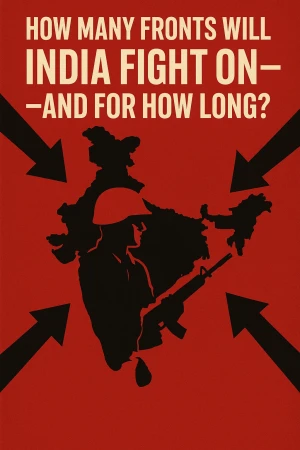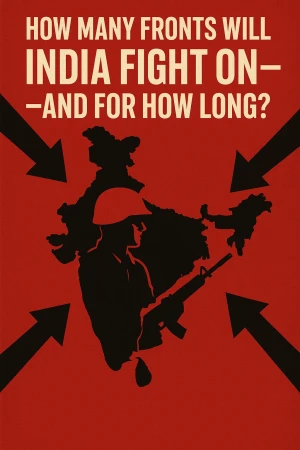"How Many Fronts Will India Fight On – And For How Long?"
Advertised as a developing nation, India happens to be working and evolving on multiple levels at the same time. These efforts involve both internal and external fronts, some more pronounced than others. It may be relevant now to analyze the various levels India is compelled to struggle on, and attempt to answer the burning question: How long is this sustainable?
1. Bollywood’s Silence - When Our Stars Fail to Stand With Us in the Battlefield
Many years ago it was Indian cinema, more specifically Bollywood, that was projecting and promoting the love for one’s country, culture, values and identity. Unfortunately, most of the industry’s contemporaries have taken to either silence or worse, paying feeble allegiance to something immensely detrimental to national disintegration.
With our soldiers being martyred,“neutral” seems to be the response too many actors. Reserved, managed, global woke (yet anti-national) dominated narratives seem to be the only topics of discussion. From the country's image, entertainment industry, all the way down to the border - patriotism has become outdated. During a precarious time such as this, when not bounded by any form of governance, what problem would it be to idolize the very figures that hold national interests ever so dear?
2. Hostile Neighbors - Refuses Host India’s Rising Issues
These immediate neighbors - China, Pakistan, and even Bangladesh - have become hindrances to its advancement:
Pakistan has continuously fought conventional and proxy wars, along with terrorism tourism, since 1947.
China has border skirmishes while economically terrorizing and infopirating India, to destabilize India.
Bangladesh, outwardly friendly politically, has growing problems such as illegal immigration and extremism bleeding into India.
These nations have one goal together; keeping India on its toes, defending and spinning all around without true progress.
हिन्दी में भी पढ़ें
भारत कितने मोर्चे पर लड़ेगा - और कब तक?
3. India as a Controlled Market – The Stance of Western Powers
The West, most notably, the US and Europe, has interests that economically and politically keep India dependent.
-
The role of Western media is now increasingly under suspicion. Today, some people’s entire lives revolve around the propagation of falsehoods — particularly Pakistan and certain Islamic extremist groups that are actively involved in spreading and promoting lies across the globe. These individuals repeat the same false narratives so frequently that they start to appear true to the world. Unfortunately, it now seems that global media is also beginning to align with Pakistan’s agenda.
Meanwhile, India and its citizens tend to stay focused on their own work, often thinking, “Why should we bother with others?” But the time has come for India to stop being merely reactive. Instead, it must take the lead in defending the truth and assert its voice firmly. India must now challenge this well-orchestrated web of lies even on international platforms.
It appears that the International Monetary Fund (IMF) is no longer just an organization for financial aid, but one operating under a specific agenda. In recent years, the IMF has repeatedly provided economic support to Pakistan, despite the widely known fact that the country harbors and supports terrorism — it was, after all, where Osama bin Laden was found. For this reason, some people have even started calling the IMF the "Islamic Mujahideen Fund." Yet international institutions continue to blindly support such nations, making it even harder for countries like India to fight on multiple fronts at once.
During the Russia-Ukraine war, we saw how Western lobbyists and policy planning bodies were more than willing to push Indian policy.
Fundings and NGOs that promote anti-India narratives under the banner of human rights advocacy.
Attempts by India to become self-reliable, be it in defense, energy, or technology, get faced with the same Western powers nuanced resistance or condemnation.
India, not viewed as an equal, but open as a consumer base that needs political control.
4. Enemies Within – Leftists and Pakistan Sympathizers Among Us
Perhaps the most dangerous battle India faces today is not from outside, but from within.
Radical leftist ideologies have spread widely, permeate through our universities, the media, and even places which formulate policies.
Movements like the so-called "tukde-tukde gang" try to divide and rule this nation by provoking strife over any and everything — be it Kashmir or even the citizenship laws.
Their propaganda is aimed at India, and yet it is too much substantiated by the Pakistan’s propaganda machinery. The correlation is very uncanny.
These elements misuse freedom of expression to poison people’s minds, call in question the very foundations of the Indian state, and create doubts not only about the government but even the country itself.
5. Vote Bank Politics – When Leaders Betray the National Interest
A democracy should prioritze the needs of the nation, which should be above everything else. Unfortunately, in India, vote bank politics has undone all focus on the national interest.
Political leaders have decided to prioritize appeasement instead of justice, as well as electoral strategies instead of long term plans. Building up to anti-terror laws legislation and refusing reforms just so they could keep certain vote blocks shows how much harm has been inflicted upon India’s unity. Nationalism is labelled as toxic and proponents of pro-India policies are branded extreme for the sake of votes.
6. A Compromised Media – Selling Narratives Not Truth
Fearless reporting is how Indian media used to be described. However, now, a significant section has succumbed to the TRP greed and ideological bias. They now have moved from informing the populace to functioning as mouthpieces for partisan agendas.
Mainstream debate has plenty of room for twisting facts, ignoring important things, and even exaggerating unimportant things. Some media figures actually defend the anti-national rhetoric or those who openly oppose national unity. Misinformation breeds public distrust, and for the most part, the effortlessly influenced youth.
7. Youth in Confusion - No Direction, No National Vision
India's youthful populace serves as its greatest treasure, but at the same time, the most susceptible demographic.
Career ambiguity, the pressure of unemployment, stress, and identity crises has left many disillusioned. They are succumbing to the traps of radicalism, toxic activism, and substance abuse.
The absence of value-based education coupled with indiscriminate Westernization further alienates the youth from Indian roots. They are no longer in the position to aid the nation in its construction, but rather, are being woefully misled into its deconstruction - emotionally, ideologically, and psychologically.
8. The Rise of the ‘Tukde-Tukde’ Gang
There exists a well-networked ‘intellectual’ lobby within India which actively promotes the idea that India is the problem. Under the guise of “freedom” they largely mean the ability to divide the nation.
These people actively exploit student protests, activist forums, and selective outrage to attack India’s Kashmir, army, and Constitution. Many of these people are foreign funded, or at least ideologically aligned with foreign interests. Their emergence stabs India’s unity in the back from within.
9. Cultural Erosion – The Infiltration of “Woke” Culture
A different kind of cultural invasion has begun, not with weapons, but with subtle ideas that masquerade as advancement. Institutions with “woke” culture go against India’s traditions, family values, festivals, and even its religious identity.
Correcting political misunderstandings is important, but embracing one’s roots in the name of modernization is counterproductive. Influencers propagate everything from gender roles to religion, the Westernized and Indocentric frameworks which are antithetical to the Indian civilization paradigm. This leads to a fractured society — people who have no idea what they’re doing, are ashamed of where they’re coming from, and are lost about what lies ahead.
10. Economic Warfare – Struggles on The Domestic Front
Internationally, India’s economy does not only have external enemies to contend with; it also fights externally inefficient, overregulation, and lobbying aimed at small businesses and farmers.
The backbone of employment in India, MSMEs (Micro, Small and Medium Enterprises) are, They are, for the most part, constituents of the vast unserved market that are subjected to administrative hurdles.
Farmers are politically used and policy-wise neglected, caught in between apathetic policies.
While big corporates enjoy a global stage, the ordinary Indian entrepreneur struggles to lift off.
Strategic might flows from economic strength. If India expects to fight global wars, it must first win its internal ones.
11. Cyber & Digital Attacks – The Invisible Frontline
The digital infrastructure of India has come under increasing fire. Chinese hackers, state-sponsored cyber terrorists, and global disinformation syndicates routinely assault:
-**Government data
Finances
Public perception through social media
Cyber warfare does sail without tear and destruction, but the damage but the damage it inflicts is catastrophic. There will be no remnants akin to bombs, but it can disrupt institutional order, erode impenetrable borders, forcibly cripple an ecology and carefully controlled ecosystems. As India's rapidly expanding digitally infrastructures turns to infrastructure, the speed of cyber offense must be outpace faster.
12. Religious Polarization & the Conversion Mafia
India is a multi-faith civilization; nevertheless, that diversity is being hijacked by extremist multiple bodies.
Religious conversion mafias -both indigenous and externally sponsored -covertly operate within fragile societies and communities and use persuasion bordering on deceit or threats.
Instead of being peaceful, some are bent towards promoting discord motivate people to question the Hindu civilization, turn and fabricate histories. It increases polarization which undermines everything India has anchored been based on for centuries.
Conclusion: A Nation at War on 12 Fronts
India is not just battling on its borders. It is battling:
On college campuses
In the living rooms of its citizens
Within the Parliament
On social media platforms
And in the consciousness of its society
In order for India to surmount its challenges, the citizen awakens, and the youth rallies, this consciousness shift is imperative for change. War heroes alone is not what India seeks; it desires insightful participants, ethical leaders, and media that takes responsibility for its narratives.
This enables us to meaningfully contemplate the question—‘How long will India keep fighting?’
Conclusion: How Long Can India Keep Fighting?
Focus shifts from how many fronts India will continue to fight with how long it can sustain this pressure.
In all honesty, these fights will continue unabated until the people of India rise together decisively and unambiguously. Thankfully, some semblance of a national awakening is emerging – especially among the youth who are questioning media narratives and embracing nationalism unabashedly.
But for India to truly arise, it must:
Deal with its internal enemies with as much focus as the external ones.
Fortify its cultural and national ethos.
Hold its influencers, policymakers, and institutions accountable.
Only then can we shift the narrative from “How long must we fight?” to “How can we finally win?”
Note:We’ve tried our best to share our thoughts on all the points, but if anything has been missed, feel free to share your input in the comments—we’ll do our best to include it in the article.



